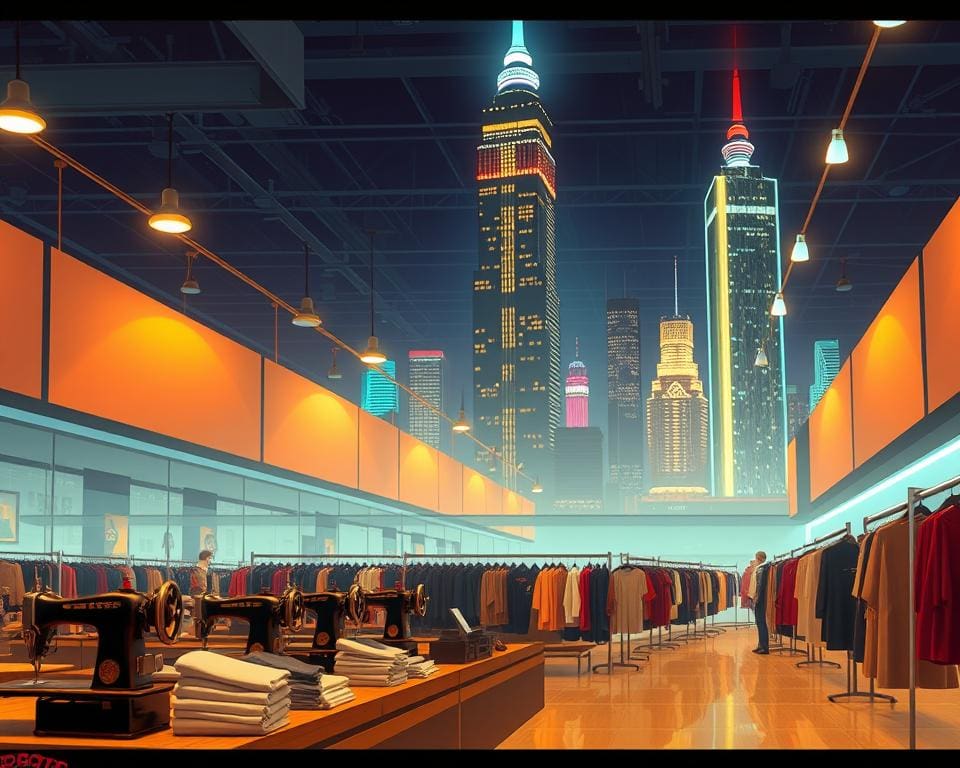Fast fashion, a term that evokes rapid production and accessible pricing, revolutionised the retail landscape in recent decades. To understand when did fast fashion begin, it’s essential to explore the interplay between consumer demands and historical context that fueled its inception. The rise of the fast fashion industry has transformed how we perceive clothing and consumption, prioritising speed and affordability over sustainability. By examining its origins, we can gain insight into the broader implications of this phenomenon on society and the environment.
Understanding Fast Fashion
The fast fashion development phenomenon has reshaped the clothing industry, marking a significant shift in how consumers engage with fashion. This model prioritises speed and accessibility, allowing brands to rapidly produce garments that reflect current trends. Subsequently, this cycle of creation influences various aspects of consumer behaviour and the fashion landscape.
Definition and Characteristics
Fast fashion is defined by its ability to deliver stylish clothing items at affordable prices. Key characteristics include:
- Frequent inventory updates that keep pace with changing trends.
- Mass production techniques that lower costs and increase output.
- Quick turnaround times from design to retail availability.
The evolution of fast fashion has been significantly driven by advancements in technology and global supply chains. These factors enable brands to react swiftly to market demands, fostering an environment where consumers expect new merchandise almost regularly.
Why It Matters Today
Fast fashion’s relevance is underscored by its impact on modern retail practices and societal norms. Increasingly, discussions surrounding sustainability and ethical consumption have emerged, questioning the long-term viability of this industry. Many consumers are beginning to recognise the implications of rapid consumption on the environment and social structures. The ongoing fast fashion development challenges us to consider our purchasing choices and their broader effects on the fashion ecosystem.

When Did Fast Fashion Begin
The phenomenon of fast fashion began to take shape in the late 20th century, with significant developments evident in the 1990s. Brands like Zara and H&M emerged as leading players, redefining the clothing landscape with their ability to swiftly bring new designs to market. This marked a pivotal transition from the traditional, slower fashion cycles that had characterised the industry for decades.
As manufacturing processes evolved, the fast fashion origins became clearer. Retailers streamlined production, enabling them to respond rapidly to changing consumer preferences. This shift created a culture of immediacy, where shoppers began to expect the latest trends at a moment’s notice. The rapid design cycles not only transformed how fashion was consumed but also affected the entire industry, including marketing and supply chain strategies.
Through these transformative years, one question resonated: When Did Fast Fashion Begin? Understanding this timeline offers insight into the broader implications of consumerism and the fashion industry’s response to lifestyle changes in the modern era. The quest for speed and style has forever altered how we approach our wardrobes.
Fast Fashion History: A Brief Overview
The fast fashion history reveals an intriguing journey of transformation in the retail landscape, marked by rapid changes and innovations. Emerging in the late 20th century, the fast fashion industry began with a focus on delivering the latest trends to consumers at unprecedented speeds. This shift catered to the growing demand for accessible fashion, reshaping how clothing was produced and marketed.
Key milestones in this evolution include the rise of influential brands that pioneered new production techniques, enabling quicker turnaround times. Brands such as Zara and H&M significantly impacted the fast fashion industry inception by adopting a model that prioritised agility and responsiveness to design trends.
Over the years, the fast fashion history has intertwined with changing consumer behaviours, leading to an increased emphasis on affordability and variety. Retailers began to understand the importance of rapidly refreshing their collections, which significantly influenced shopping habits, turning buying into a frequent and almost impulsive activity.
As the fast fashion industry continues to evolve, its historical context remains relevant. The insights gleaned from its past help to inform current practices and sustainability discussions, shaping the future of fashion in profound ways.
Origins of Fast Fashion
The origins of fast fashion trace back to a blend of visionary leadership and technological innovation that shaped the industry. Influential figures transformed traditional clothing paradigms, driving a rapid evolution in how fashion is produced and consumed. Understanding these key influencers in fashion provides insight into the favourable conditions that birthed this phenomenon.
Key Influencers and Innovators
Amancio Ortega, the mastermind behind Zara, played a pivotal role in the fast fashion industry. His approach emphasised speed and accessibility, revolutionising retail by shortening the time from design to store. Similarly, H&M’s model of producing fashionable clothing at affordable prices became a benchmark in the market. These innovators not only changed consumer expectations but also challenged established notions about clothing production and retail.
Initial Concepts in Clothing Production
The initial concepts that underpin fast fashion revolved around leveraging technology and innovative production practices. Automation and streamlined supply chains allowed for quicker design cycles and the ability to respond to trends almost instantaneously. This shift laid the foundation for the rapid fashion cycles we witness today, reflecting a growing demand for variety and affordability in the clothing market.
Fast Fashion Industry Inception
The emergence of the fast fashion industry marked a transformative moment in the realm of retail and consumer culture. This period saw the rise of iconic fashion brands that skilfully merged style with accessibility, changing the way consumers interacted with fashion. As brands responded to shifting trends, they cultivated a more dynamic relationship with their customer base, leading to unprecedented growth in the industry.
The Birth of Iconic Brands
Forever 21 and ASOS stand out as pioneers in the fast fashion realm. Their unique approaches to trend forecasting and rapid production cycles allowed them to introduce new styles at an astonishing pace, which resonated with young shoppers eager for the latest looks. These brands focused on real-time consumer data and utilised social media as a platform for engagement, enabling them to remain relevant in a constantly changing market.
The strategic emphasis on branding played a pivotal role in solidifying the fast fashion narrative. Through clever marketing campaigns, these iconic brands positioned themselves as key players in the fashion landscape. They harnessed the appetite for novelty and immediacy, which aligned perfectly with emerging consumer behaviours and desires for affordable luxury. This connection between branding and consumer trends has underpinned the fast fashion industry’s inception, paving the way for its continued evolution.
Timeline of Fast Fashion Development
The timeline of fast fashion showcases the rapid evolution of the industry and highlights significant milestones that have shaped its trajectory. As the demand for affordable and trendy clothing soared, key events emerged, illustrating the transformative nature of this movement.
Milestones in the Fast Fashion Movement
- 1960s: The concept of fast fashion started to gain recognition, with brands like miniskirt pioneer Mary Quant paving the way for affordable styles.
- 1980s: Retailers such as Zara and H&M made their debut, introducing quick turnaround times that focused on getting runway designs into stores almost immediately.
- 1990s: The rise of mass production techniques allowed brands to produce clothing at an unprecedented scale, creating a culture of disposability.
- 2000s: Internet shopping began to flourish, enabling consumers to access fast fashion from the comfort of their homes and further driving demand.
- 2010s: The emergence of social media changed the landscape, with influencers and celebrities promoting fast fashion brands to millions of followers.
- 2020s: Growing awareness of sustainability issues prompted a shift, with many brands now recognising the need for ethical practices within the fast fashion model.
The Rise of the Fast Fashion Industry
The rise of the fast fashion industry has fundamentally reshaped the retail landscape, marking a transformative period characterised by rapid production and consumer demand. Fuelled by globalisation, brands such as Zara and H&M have thrived, leveraging supply chains that allow for quick turnaround times on trends. Consumers today are more connected than ever, leading to a surge in fast fashion growth as shopping behaviours evolve, with instant access to the latest styles and trends at their fingertips.
As businesses adapt to these consumer expectations, the implications of this rise prompt critical discussions. The notable shift towards fast fashion raises significant environmental and ethical concerns. With the fashion industry being one of the leading polluters, the impact on sustainability cannot be overlooked. Increased clothing production has led to resource depletion and a waste crisis, highlighting the urgent need for more sustainable practices within the industry.
The future of the fast fashion industry hangs in a delicate balance. While its growth shows little sign of slowing, there is a growing awareness among consumers about the need for responsible purchasing and corporate accountability. As the narrative surrounding fashion evolves, the industry is faced with the challenge of maintaining its appeal while addressing the pressing issues that accompany its remarkable ascent. This critical moment may very well define the legacy of fast fashion and influence consumer culture for years to come.









